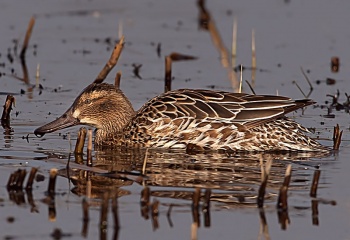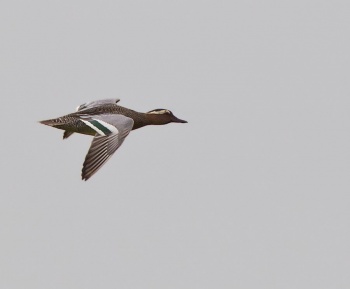- Spatula querquedula
Identification
Garganeys are quite small ducks at 37 - 41cm (14½-16 in).
The male in breeding plumage has a prominent, white supercilium. The body is heavily spotted at front and rear with pale flanks and long striped scapulars. The eclipse male resembles the female.
Females are harder to identify, being greyish overall with broadly pale-edged dark flanks. The broad pale supercilium over a bold dark eye stripe is a good id feature.
The speculum is green with white lines along the front and rear edges. The underwing pattern is prominent black and white.
Distribution
Breeding species in much of Europe and Asia. The European population is most numerous in the east. Most if not all of the European birds are found in places like the Volga Delta in the fall and they winter in western Africa (e.g., the Niger Delta), with possible occurrence in southern Sudan.
The Asian birds winter in India, Indochina (Burma, Laos, Thailand) and southern China.
Vagrants have occured in Azores, Iceland, Hawaii, Aleutian Islands and even at the west coast of North America.
The Garganey is quite nomadic in the winter areas, but even so, changes to the area as result of changes in resource utilization and global warming are expected to be the major cause of concern for the European populations of this species, which has shown moderate to strong negative trends during the period of 1970-2000.
Taxonomy
This is a monotypic species[1].
Formerly placed in the genus Anas.
Habitat
Breeds inland, preferably on wet meadows, shallow freshwater marshes, small lakes and ponds. In winter in coastal marshes and lagoons, sometimes even at sea.
Behaviour
A shy and wary duck which is often found in pairs or small groups in summer, in winter in big concentrations (eg 77,000 in Senegal).
Breeding
Starts breeding after arrival in breeding area in April and May. The nest is usually near water on ground, lined with down and feathers. Lays 8-9 eggs.
Diet
Feeds on aquatic invertebrates, amphibians, seeds, fish and aquatic plants. Like other Anas Ducks, Garganeys feed dabbling, head-dipping and also picking from surface.
Vocalisation
References
- Clements, J. F., T. S. Schulenberg, M. J. Iliff, D. Roberson, T. A. Fredericks, B. L. Sullivan, and C. L. Wood. 2017. The eBird/Clements checklist of birds of the world: v2017, with updates to August 2017. Downloaded from http://www.birds.cornell.edu/clementschecklist/download/
Recommended Citation
- BirdForum Opus contributors. (2025) Garganey. In: BirdForum, the forum for wild birds and birding. Retrieved 11 May 2025 from https://www.birdforum.net/opus/Garganey
External Links
Search the Gallery for Garganey videos:
GSearch checked for 2020 platform.1







